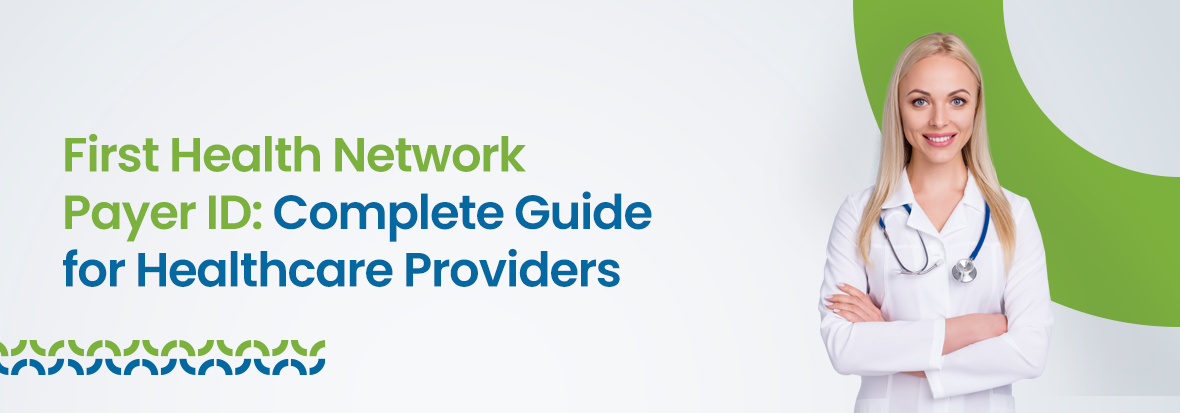Electronic claims processing is the lifeblood of a healthcare practice’s revenue cycle. With over 4 billion healthcare claims processed annually in the US, using the right payer id becomes crucial for timely payments, specifically the First Health payer ID of 95019. The FHNP id is the gateway for providers to have streamlined billing and reduced administrative overhead.
Providers working with First Health networks need specific technical information to ensure their claims get to the right place. This guide covers everything from the primary payer id number to regional coverage variations so medical billing professionals can submit electronic claims with confidence.
Key Points
- First Health Network payer ID is 95019 for electronic claims
- Network includes First Health, First Choice of the Midwest, and Cofinity providers
- Both Professional/1500 and Institutional/UB claims accepted
- Network covers most US states with regional variations
Overview
The primary payer id number for Health First Health Plans is 95019. This id number is used for electronic claims and billing for providers in the network. Whether you’re submitting Medicare claims or commercial insurance claims, this id number ensures your claims get to the right processing center.
First health network operates under HIPAA compliant billing rules and requires the use of standard code sets including ICD-10-CM for diagnosis and CPT/HCPCS for procedures. This compliance framework supports primary and secondary claims and Electronic Remittance Advice (ERA).
Technical Requirements
All claims must meet these requirements:
- Use payer id 95019 for Health First Health Plans
- Comply with HIPAA transaction standards
- Include proper ICD, CPT, and HCPCS coding
- Follow AMA coding guidelines and Medicare policies
- Adhere to Correct Coding Initiative (CCI) and Local Coverage Determinations (LCDs)
The network also allows custom billing guidelines when standard rules don’t apply, for complex medical scenarios while maintaining compliance standards.
Network Coverage and Provider Access
The health primary network covers most US territories with regional variations that providers should know and verify First Health Network eligibility for each patient. The network has three main components: First Health, First Choice of the Midwest, and Cofinity providers.
Geographic Coverage Breakdown
| Network Component | Coverage Area | Primary Focus |
|---|---|---|
| First Health | Most US states (with specific exclusions) | Broad national coverage |
| Cofinity | Michigan | State-specific network |
| First Choice of the Midwest | Idaho and Montana | Regional midwest coverage |
The secondary coverage extends to Alabama (AL), specific Florida (FL) counties and additional states not in the primary network. This structure allows providers to access network resources no matter their location.
Provider Network Access
Curative members have special access to all network components. This means patients with Curative coverage can see First Health, First Choice of the Midwest and Cofinity providers without network restrictions. This expanded access gives patients more choice and simplifies provider network participation.
Claims Submission Requirements
Healthcare providers need to know specific submission requirements to ensure claims are processed correctly. The network accepts both Professional/1500 and Institutional/UB claims through the same payer id system, making it easier for multi-service providers.
Professional Claims (1500 Forms)
Professional claims require:
- Payer ID 95019 in the correct field
- Provider NPI numbers
- CPT/HCPCS procedure codes
- ICD-10-CM diagnosis codes
- Patient demographic information
- Service date ranges
Additional CMS‑1500 billing tips include entering Payer ID 95019 in box 1a, using the patient’s correct policy number and ensuring CPT/ICD codes match documentation.
Institutional Claims (UB Forms)
Institutional submissions need:
- Same payer ID 95019 designation
- Revenue codes for facility services
- Bill type designations
- Principal and secondary diagnosis codes
- Discharge status when applicable
Secondary Claims Processing
The network supports secondary claims processing so providers can submit claims when First Health is the secondary payer. This is important for Medicare supplement and coordination of benefits scenarios. Providers should ensure primary payer information is complete before submitting secondary claims to avoid processing delays. Before filing, use the standard methods to verify Medicare eligibility to confirm that Medicare remains the primary payer.
Contact Information for Network Access
Different network inquiries require different contact numbers to get to the right support teams. For paper claims, always send correspondence to the official First Health Network claims address listed on your payer sheet. Knowing which number to call can reduce hold times and improve resolution.
Tired of Billing Delay?
Special Benefits and Programs
Curative members get enhanced benefits that differentiate the first health network from standard insurance. These programs benefit both patients and providers.
Member Benefits Structure
Curative members get:
- $0 deductible for in-network care
- $0 copay for covered services
- Enhanced prescription coverage
- Expanded provider network access
Baseline Visit Requirements
Benefits activate after a Baseline Visit within 120 days of enrollment. This visit serves multiple purposes:
- Health Assessment: Comprehensive evaluation of member health status
- Care Coordination: Establishment of primary care relationships
- Benefit Activation: Triggers enhanced coverage options
- Prescription Access: Enables preferred prescription coverage
Providers should schedule these visits for new Curative members to get them full benefit access. The baseline visit also creates opportunities for preventive care discussions and health education.
Employer Group Services
The network participates in employer group services, providing additional value through partnership arrangements. These services often include:
- Custom benefit designs
- Wellness program integration
- Employee health education resources
- Specialized provider networks
Understanding these programs helps providers serve employer-sponsored plan members and can bring more patient volume through group contracts.

